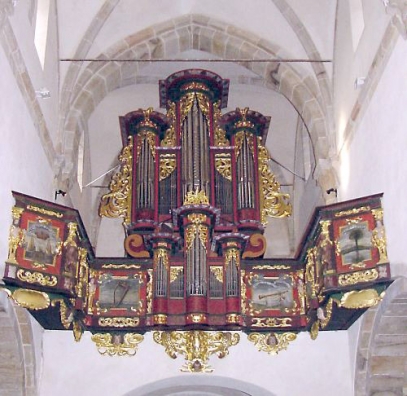

Sulejów
Florian Oleski 1644
State of preservation: Case and certain parts 1644; in 1701 moved to the present organ gallery. Repair in 1787 by Christian Wilhelm Scheffler of Brieg; further repairs 1829, 1847, 1858, 1891, 1931, 1965-69; restored 2004 by Szczerbaniak (Łodz) including reconstructions of reed stops.
The instrument represents a type of organ, which was destroyed elsewhere during the 30 years' war (or could not come into existence). The number of stops within separate divisions is almost identical, the rich pedal with a mixture stop of many ranks follows the double function of bass fundament and melody keyboard. The positive has only diapasons, apart from the two flutes and a reed stop in 4', while the main organ contains some more modern colour stops in 8', here the Rurflet (chimney flute) and Salicional, typical for Habsburg organ style.
Specification:
II+P; manuals C-c3, pedal C-c1
HW:
Pryncypał 8’
Salycinał 8’
Rurflet 8’
Oktawa 4’
Kwinta 3’
Oktawa 2’
Sedecima 1’
Mixtura 2’ 4f.
Trąba 8’
Pozytyw:
Flet major 8’
Pryncypał 4’
Flet minor 4’
Kwinta 2 2/3’
Oktawa 2’
Mixtura 1’ 3f.
Trąbka 4’
Pedał:
Pryncypał 16’
Pryncypał 8’
Salycinał 8’
Rurflet 8’
Oktawa 4’
Mixtura 4’ 6f.
Pomort 16’
Cynk 2’
Cymbelstern
© Greifenberger Institut für Musikinstrumentenkunde | info@greifenberger-institut.de




